Stolby, Stolby
Alexander Berman
 When climbing a rock alone without a rope any error could be fatal. When climbing a rock alone without a rope any error could be fatal.
I always climbed rocks on Stolby in company with those who had each
stone at their fingertips. They taught me how to use a tiniest notch in
the rock and showed well-tried movements to be imitated precisely at
complicated pieces of routes.
I think of my first experience with Stolby as I was hanging on the even
wall of Mitre over sixty metres of precipice. Listening to advises from
above of how to place my hand I suddenly imagined my foot slipping, and
then came the fear and a sharp feeling of loneliness.
It was later, at a higher and still harder route, reasonably called
Hallelujah, that I appreciated the magic bonds of human voice, no less
tangible and solid than a rope. To surmount this piece, one should lean
with his right hand on a half-palm slanting ledge, pull himself up, fold
himself like a pen-knife, and place the leg onto that shelf. Meanwhile the
left hand should go up to catch a groove above. And it failed! Balancing
in this unstable position I suddenly felt the wall swaying. The confidence
returned the very next moment, as if I caught a rope; I stretched harder
and reached the hold. And only after I had stood up and looked around
taking a deep breath, I realised the endearing whisper I heard a second
before: ‘A little more, a little, just a bit… That’s it!’
That summer I came to Stolby once again to relieve the acute feeling of
risk while “free climbing” without a rope. It was Sunday and thus all
crowded. In vain I tried to find my friends, Daddy Karlo, Dick, Gapon (stolbists
always use nicknames, so we are often unaware of their real names). None
of them came to Stolby that morning, but I met two other young guys, Grey
and Artist.
 We climbed together up First Pillar along the easiest and the most
popular route called the Rolls. Grey was far ahead. He often stepped off
the way into more difficult paths, and kept talking - ‘The stone looks
smooth, but actually it is rough and porous. Push yourself up and go…
Don’t press yourself to the rock, stand up strait …’ He ran up a
steep rock and a second later was already five meters above me. - ‘We
used to think it was a top flight until we dared to try it once ourselves.
Come on, try!’ - I did and ran up the reddish rock, pushing myself hard
with every step, and took a sit next to Grey. We climbed together up First Pillar along the easiest and the most
popular route called the Rolls. Grey was far ahead. He often stepped off
the way into more difficult paths, and kept talking - ‘The stone looks
smooth, but actually it is rough and porous. Push yourself up and go…
Don’t press yourself to the rock, stand up strait …’ He ran up a
steep rock and a second later was already five meters above me. - ‘We
used to think it was a top flight until we dared to try it once ourselves.
Come on, try!’ - I did and ran up the reddish rock, pushing myself hard
with every step, and took a sit next to Grey.
A Sunday stream of people was flowing by, some outrunning, others
jumping. A girl stopped, lost her balance and her arm was about slipping
off. A young man nearby pressed it to the rock and pushed the girl
slightly up, then bent himself and jumped aside to keep his own balance.
Another girl was speaking to somebody below and, unwillingly, was
approaching the edge to see her partner. Grey interrupted his story, -
‘Hey, 're you, eager to fall?’ - ‘No, I am holding tight!’ -
‘Everyone would think the same.’
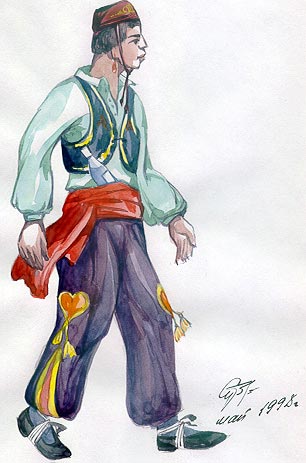 The route is so easy that it's hard to tell a skilled climber from a
beginner. There was a time when stolbists used to wear a uniform -
embroidered waistcoats, decorated fezzes, wide trousers, sashes (red, blue,
yellow), and galoshes. A sash was not a mere matter of garment. This strip
of satin, up to ten metres long, wound around the waist could be used as a
rope. Sashes and galoshes were common, but few climbers wore the complete
uniforms, with waistcoats and fezzes. To wear the uniform one had to learn
climbing for years, as it meant an obligation to take the hardest and most
dangerous ways, either to prove being in the caste or to save anyone
helplessly hanging on the rock, as it often happens on crowded pillars. To
wear an unmerited uniform was equivalent to shame or suicide. It was a
free-will garment of high virtue. However, the local authorities fighting
against yoots simply prohibited the waistcoats, the sashes, and the fezzes
not looking very much into the origin of the unusual clothes. Old
stolbists don't like to talk about it, ’Never mind the uniform, Stolby
are still there.’ The route is so easy that it's hard to tell a skilled climber from a
beginner. There was a time when stolbists used to wear a uniform -
embroidered waistcoats, decorated fezzes, wide trousers, sashes (red, blue,
yellow), and galoshes. A sash was not a mere matter of garment. This strip
of satin, up to ten metres long, wound around the waist could be used as a
rope. Sashes and galoshes were common, but few climbers wore the complete
uniforms, with waistcoats and fezzes. To wear the uniform one had to learn
climbing for years, as it meant an obligation to take the hardest and most
dangerous ways, either to prove being in the caste or to save anyone
helplessly hanging on the rock, as it often happens on crowded pillars. To
wear an unmerited uniform was equivalent to shame or suicide. It was a
free-will garment of high virtue. However, the local authorities fighting
against yoots simply prohibited the waistcoats, the sashes, and the fezzes
not looking very much into the origin of the unusual clothes. Old
stolbists don't like to talk about it, ’Never mind the uniform, Stolby
are still there.’
A boy daringly jumped down from somewhere onto the narrow ledge next to
us. A girl was slowly following him facing the rock. The guy greeted Grey
and showed him one of his galosh, - "I've worn it through since
morning!" The galosh was examined closely. Meanwhile the girl, who
kept coming down silently, was already close to us but scared to jump. She
bent her knees, squatted (tight jeans, metal rivets on the hip-pockets)
and jumped down keeping hardly her balance. The guy, continuing his galosh
story, braced up but didn’t give his hand. The girl (bleached blond, big
painted eyes) looked at him angrily "Why, you?!" And the
discussion about went on.
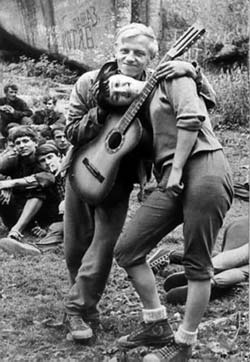 "I love First Pillar", - says Grey. - "It's always
crowded. The paths are blocked up, but those in a hurry climb on the
fringe. One finds the way, the others follow him. What tricks they play!
There are thousands of paths here! Each encourages to prove yourself and
to watch the others thus mixing 'business with pleasure'. Once many guys
gathered here. What a climbing it was! One would need five years to repeat
that! It was then that San'ka climbed head over heels". - "Is he
really good at walking head first?" - "No, not very, but he
upped and did it. Few have been able to repeat that". "I love First Pillar", - says Grey. - "It's always
crowded. The paths are blocked up, but those in a hurry climb on the
fringe. One finds the way, the others follow him. What tricks they play!
There are thousands of paths here! Each encourages to prove yourself and
to watch the others thus mixing 'business with pleasure'. Once many guys
gathered here. What a climbing it was! One would need five years to repeat
that! It was then that San'ka climbed head over heels". - "Is he
really good at walking head first?" - "No, not very, but he
upped and did it. Few have been able to repeat that".
I could never catch when his stories graded into illustrations. And
that time again - scarcely I tried to protest, he was already setting off,
head first, down the steep rock, and I could only see his galoshes, his
long neck, his open arms, and fingers spread apart. Some coins dropped
from his pockets, rolled jingling and silently disappeared in a precipice.
Several coins got stuck in the cracks, and Grey, laughing, still head
first, tried to pick them. Then he climbed up and joined me, but at that
moment Artist ventured into the BIF crest (a very dangerous route
discovered by Belyak Ivan Filippovitch, a teacher). A cigarette in his
mouth, Artist easily covered the first part of the route, but suddenly
stopped not far from us. He was palpating the stone, threw away his
cigarette, raised his elbows trying to relax. - "There's hardly a
chance to get out", - Grey said. While sitting comfortably on our
stone, we could see Artist three metres far from us, relaxing his arms,
breathing deeply. Grey was waiting anxiously. Finally Artist found some
handholds, clambered over the stone, sat down and asked, - "If one's
hands shake, is it from fear or from tension?’
I was following Grey up First Pillar along the route called Question.
The "question" is whether you jump down onto a small stone below
and hold tight. I could see the ground and people far below, and Baby
Elephant with many people on and around, and the wind brought voices up
from there.
Grey already jumped down and was inviting me to join him waving his arm
as a circus trainer. He was saying something but I was deaf from fear.
Shall I come back? I didn't realise how I jumped and felt myself flying.
Hardly had I reached the solid surface, I saw Artist's long legs already
in the air above me and nicked to step aside to let him on the stone. His
was a perfect landing, and we continued.
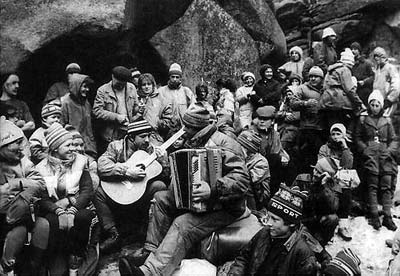
I was writing this and thought that anybody might feel my stories
encouraging for hot heads risking to climb without stand by. Hopefully not,
however. The consequences of a fall are so vivid that no word can add
anything to the understanding of danger.
Attractive examples are dangerous where the danger is not obvious, say,
on slipping snowy slopes. These slopes seem so inviting at the first sight,
and a happy tourist enjoys a sunny day and, unaware, runs ahead straight
into a hug of the "white death". Thus, writing tales about
mountain skiing requires much caution.
I think taking risks at random makes no sense. This is the way of a
lazy body, - better to take a risk than walk around, - or of a lazy mind,
- better to hope for good luck than think. Those who risk blindly just
never set their will and skill against difficulty and danger.
Stable rocks where the danger is obvious are quite a different matter,
though sometimes people fall off …
The next day we set off to the Wild pillars. We were in a hurry as it
was late and getting dark and there were fifteen miles of the taiga ahead.
I was tempted to try the Wilds which was then unusual.
The guys, experienced mountaineers, were running like deer even talking
on their way. They were talking over mountains and hardships they met
during long walking trips. I was running along and my heart was beating
regularly and joyfully, but I knew much harder times. I learned once that
the only tough thing in a trip was to be the weakest, and the recovery
took three years. Fortunately my companions didn't know that.
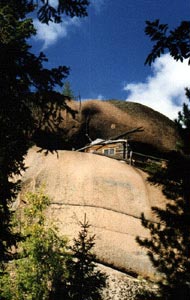 We arrived in the dark. It was unusual and terrifying to climb rocks at
night. At last we had reached the hut called Griffins, a timber hut built
on a ledge high up the rock of the same name. When building it, people
used a winch to lift the logs from the rock foot. The hut is very nice and
matches perfectly the rock architecture. It was a pleasure to get inside
the safety of a home and to sprawl on a wide plank bed after the night
climb. We arrived in the dark. It was unusual and terrifying to climb rocks at
night. At last we had reached the hut called Griffins, a timber hut built
on a ledge high up the rock of the same name. When building it, people
used a winch to lift the logs from the rock foot. The hut is very nice and
matches perfectly the rock architecture. It was a pleasure to get inside
the safety of a home and to sprawl on a wide plank bed after the night
climb.
I asked Victor Yanov, our guide, if the "genuine stolbists"
ever fall off. - "Not more often than expert mountaineers. They have
some inner feeling, some intuitive skill to calculate. A good climber
never takes up a route without feeling sure. There is a chimney leading
from below to Communard - a block on First Pillar - called Abalakov's (whether
it's true or not, they say Yevgeny Abalakov, the famous mountaineer, used
to do it once). The best climbers worked it using safety ropes, but failed.
And a guy nicknamed Simochka once tried it simply unroped and suddenly
found a way through. - Was he the most skilled climber? Who knows.
Simochka usually climbed smartly, without a least effort, and always
smiling. It was impossible for him to fall. He was a mechanic on a ship
and died elsewhere. I wrote down his name on Mitre." -
"Or Dusya Vlasova, she would have never fallen, had it not been
for one guest mountaineer from Perm who got stuck on Takmak. Although many
boys were staying at the foot, it was Dusya who set off for rescue as she
was the best climber. She was on her way up when the guy slipped off and
barged her down. Fortunately, it was not too high. The guy was hurt badly
however, but Dusya was lucky to only have broken her leg. In a week she
came to Stolby with crutches and thus climbed up First Pillar along the
Rolls. Then guys carried her to other rocks on their back."
I saw Dusya the day before. She was sitting on a stone beneath Second
Pillar. Grey gave her a smile and patted her short ginger hair. The guys
spoke about Dusya Vlasova as if everybody was supposed to know her.
I used to know Dusya's elder brother, Victor, who had been a stolbist
since cradle and learned his ABC on the rocks. He was a lightsome climber,
always with his guitar on his back, climbing down the hardest routes head
first. He used to climb Communard with a samovar and firewood, made
pancakes up there and invited everybody to join him, though few were able
to do. He is known for a very generous person who would give away
everything he had to anybody. He could never fall off and people near him
never did. He used to live in the reserve weeks long picking mushrooms and
berries. He was nicknamed Gapon, nobody knows why. Six years ago during my
last trip to Stolby, I was sitting near a bonfire and saw a tall guy
emerged from the dark. I understood he was Gapon from the impression his
appearance produced on my companions around the fire. He sat aside and
kept off the talk, only sang a song about loneliness on the rocks.
I heard Gapon was taken for a governor of Stolby, but the guys told
that was rubbish. There can't be any governors or kings on Stolby as there
can't be majors among the majors.
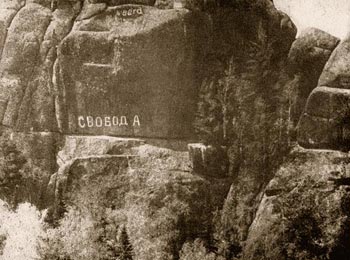 A wall on Second Pillar bears an inscription "Freedom", an
inscription with oil on a bare wall far from any possible routes. It has
existed since pre-revolution times but the letters are occasionally given
a fresh coat of paint and don't fade away. Before the Revolution people
put up red flags high on the rocks. Once somebody put up a flag on top of
Big Golden Eagle at night, though the rock is impossible to climb even in
the daytime. So, the police had to shoot it down from the ground. A wall on Second Pillar bears an inscription "Freedom", an
inscription with oil on a bare wall far from any possible routes. It has
existed since pre-revolution times but the letters are occasionally given
a fresh coat of paint and don't fade away. Before the Revolution people
put up red flags high on the rocks. Once somebody put up a flag on top of
Big Golden Eagle at night, though the rock is impossible to climb even in
the daytime. So, the police had to shoot it down from the ground.
It was Victor Yanov who told me the story. He's a professional artist
and made an engraving called "A flag on Golden Eagle". He told
people could climb the rocks even at night, for the routes are usually
short and can be memorised by touch. Stolbists often bet they can climb
the rocks even when blinded. There were veterans who had come blind from
the war but climbed by memory. However, climbing alone at night is
dangerous. Victor told he climbed Takmak in the dark when a boy and left
his knife on the top as a proof. Since then he has climbed Takmak solo at
night every spring for years just to make himself sure he's still young.
Big Golden Eagle is very hard to climb.
I have already told how I was climbing with Grey and Artist along the
easy and pleasant way of Rolls. However, I held back that the trip began
with an ordeal painful for my self-esteem. Now I feel liking to lay bare
how I tried to do Mitre. That happened not because I spent a sleepless
night on the plane or because I met a boy and a girl who had fallen off a
rock just before my arrival and I was carrying them on a self-made
stretcher. That time I came just to write about Stolby and to observe
myself in the acute feeling of risk. So I took up Mitre but suddenly asked
for a safety rope already in the middle of the way. Sergei Prusakov, an
expert climber patiently waited for me and tied the rope on my waist. I
continued my way up feeling excited and thinking about anything but the
route I was following when all at once I saw Sergei who took me over along
another route. Then he went up incredibly on a bare wall - I had never
seen anything like that before, I forgot we were on Mitre but just
wondered what he was holding on and what would happen.
That time I felt nothing special at the top. I went down to the safe
flat, again with the safety rope. Far below I could see green branches of
birches and cedars growing right from stone. Above on the wall I saw
Artist going down. Suddenly he mistook a cling hold and was obviously
stuck with his one leg unsupported and the other shaking menacingly.
Sergei spoke almost rudely, - "You, guy, hold on the cling and change
your legs! Don't be silly, or you fall!".
Artist found the cling holds, reached the fissure and put his hand
inside. Then it was something incredible that followed - he went up and
down again taking right the same way. - "That's it" - Sergei
encouraged.
 Then we climbed Second Pillar along the Leushinsky route. That time I
climbed unroped, which is common on Stolby. We took a narrow gradually
opening chimney and I felt safer sheltered from the empty space around.
Sergei was nearby. His self-confidence seemed strange and even annoying.
Suddenly I thought by caprice - "What if I try to fall off? What will
he do?" Indeed, when going down, I was insolent to jump and felt my
foot slipping. Sergei stopped and explained firmly that my behaviour was
absolutely intolerable. That was how I understood the rules: to be as
careful as possible myself and the others will charge themselves with the
rest. Then we climbed Second Pillar along the Leushinsky route. That time I
climbed unroped, which is common on Stolby. We took a narrow gradually
opening chimney and I felt safer sheltered from the empty space around.
Sergei was nearby. His self-confidence seemed strange and even annoying.
Suddenly I thought by caprice - "What if I try to fall off? What will
he do?" Indeed, when going down, I was insolent to jump and felt my
foot slipping. Sergei stopped and explained firmly that my behaviour was
absolutely intolerable. That was how I understood the rules: to be as
careful as possible myself and the others will charge themselves with the
rest.
I thought then it was natural for a human to be extremely careful
otherwise the rashness may cost a life. Civilisation has spoilt people,
whereas they subconsciously seek to risk. However, bull fights would
sicken me, as well as fiercely competitive games, where malice is
inescapable. Rocks is quite a different matter.
I asked Sergei why, a professional mountaineer, he let beginners go
without safety ropes, and what he could do if somebody was slipping a
metre off him. "Actually the rope doesn’t matter" - he says, -
"I can spot when somebody is about falling and come up to give him a
hand." - "All people need, is a bit of support, a small effort,
because they hold perfectly by themselves".
Two days later I was leaving Stolby. I was walking alone along the
deserted path and stopped at Mitre to read once again the two memorial
signs on the wall “Vladimir Denisov, Sima, 1939-1962” and “Tsedrik
Alik, 1947-1968”.
Suddenly I thought I was leaving for Moscow and did not know when I
would be back. So it was very important for me to surmount Mitre, more so,
to do it alone. I set off, stopped at the swaying stone, sat astride it
and looked down. Finally I decided to continue and was about climbing up
… And - it started to rain. Climbing Mitra in the rain is absolutely
impossible and I met the rain as a salvation … |
|

